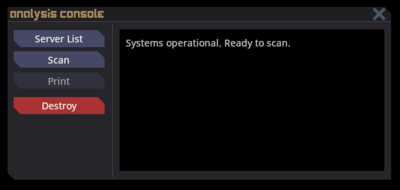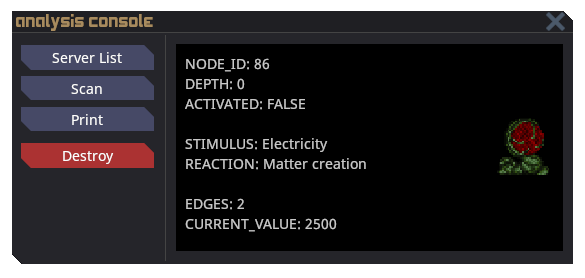Xenoarcheology: Difference between revisions
Created xenoarcheology page |
stimulus examples |
||
| Line 66: | Line 66: | ||
It is important to note that each scan functions as a static snapshot of the current node. It does not update with the artifact and will only update when scanned again. | It is important to note that each scan functions as a static snapshot of the current node. It does not update with the artifact and will only update when scanned again. | ||
===Stimulus=== | |||
Some examples of stimulus interpretations (i.e. how to cause the artifact to make a reaction): | |||
* Hydro-reactive - Spray a fire extinguisher or spill a bucket of water onto the artifact | |||
* Sonic Vibrations - Play a musical instrument close to the artifact | |||
* Magnetic Vibrations - Equip Magboots and walk on the artifact | |||
* Extreme Pressure - Carry the artifact into space or space the room it is in (use caution and common sense here. This does not give you the right to endanger others or demand a hardsuit) | |||
* Physical Trauma - Punch the artifact or hit it with a blunt object via [[Combat|Combat Mode]] | |||
* Electricity - | |||
Revision as of 00:13, 6 January 2023
Xenoarcheology is a method of point generation for R&D utilizing randomly generated artifacts. It is the job of scientists to discover and activate the secrets of these artifacts.
Equipment
The actual experimentation of artifacts uses a variety of equipment that can be found scattered around the station. This specifically focuses on the specific items used and contained within the xenoarcheology lab.

Analysis Console
The analysis console is the main method of getting information about the artifacts that are being researched. In order to properly use it, it must be linked to an artifact analyzer via multitool as well as have a research server selected.
From the console itself, the screen displays information about the last artifact scanned. The buttons along the side perform various functions:
| Button Name | Description |
|---|---|
| Server List | Opens a menu for selecting a research server. |
| Scan | Scans the artifact currently on top of the linked pad. Scanning has a large energy intake and takes about a minute to complete for base-level artifact analyzers. |
| Prints a paper copy of the scan. Can only print one copy per scan. Useful for manually organizing scans. | |
| Destroy | Destroys the artifact, converting it into research points for the selected server. |
Artifact Analyzer
The artifact analyzer is a machine used in conjunction with the analysis console to scan artifacts to discover information about them. It can be upgraded with machine parts in order to reduce it's power intake as well as the duration of its scans. Artifacts are scanned by placing them on this machine before pressing the "scan" button on the console, which will cause it to scan unless interrupted by either being moved off of the machine or by being activated.
Artifacts
Artifacts are the core of Xenoarcheology and are what scientists will be analyzing and experimenting on. Artifacts can take on a variety of random appearances and can be acquired in various ways, such as through finding them in the lab at the start of the round, purchasing them from Cargo, getting them from Salvage, or finding them from the Bluespace Anomaly station event.
Artifacts consist of randomly generated "trees" which dictates the artifacts behavior. Each tree consists of various "nodes" which the artifact can be inside of. Nodes each contain a "trigger" and an "effect". Effects can be both passive, constantly occurring while inside the node, or active, occurring only when the artifacts trigger is met. Triggers cause the artifact to shift to a random adjacent node in the tree.
The activation of the various nodes is the main goal of Xenoarcheology. Unlocking the nodes of an artifact increases its value, both in research points and in spacebucks.
Analysis Interpretation
Each scan of the artifact analyzer gives various data about the artifact:
| In-Game Phrase | Meaning | Description |
|---|---|---|
| NODE_ID | ID | A unique ID number corresponding to each node. Can be used for identification. |
| DEPTH | Node tree depth | The distance from the starting node of the tree. Higher depths correspond to more dangerous and harder to activate artifacts which in turn increase the value when discovered. |
| ACTIVATED | Activation | Whether or not the "trigger" for the node has been activated. |
| STIMULUS | Trigger | A hint about the specific trigger for this node. Usually gives a good idea about what activates the artifact. |
| REACTION | Effect | A hint about the effect for this node. Usually is vague and non-specific. |
| EDGES | Neighboring nodes | The number of nodes that are adjacent to the current node. This is the number of different options for traversal when the artifact is activated. |
| CURRENT_VALUE | Point value | The number of research points that the artifact will give if destroyed. |
It is important to note that each scan functions as a static snapshot of the current node. It does not update with the artifact and will only update when scanned again.
Stimulus
Some examples of stimulus interpretations (i.e. how to cause the artifact to make a reaction):
- Hydro-reactive - Spray a fire extinguisher or spill a bucket of water onto the artifact
- Sonic Vibrations - Play a musical instrument close to the artifact
- Magnetic Vibrations - Equip Magboots and walk on the artifact
- Extreme Pressure - Carry the artifact into space or space the room it is in (use caution and common sense here. This does not give you the right to endanger others or demand a hardsuit)
- Physical Trauma - Punch the artifact or hit it with a blunt object via Combat Mode
- Electricity -




